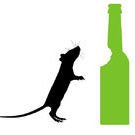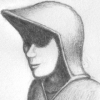I have invented a board game. It’s sort of between chess and a wargame. I like the clarity, simplicity and exactitude of chess, but it’s not a very faithful representation of a battle (nor does it claim to be, of course). I like the way wargames represent more closely actual battle, but they are messy and complicated and time-consuming (and I am embarrassed to play with little soldiers). So I have tried to make a game that takes the best of both.
It's a two-player game. There is a board that is divided into squares (2 or 3 hundred of them). Each person has an army made of a number of units and he lines them up, like chess, on his side of the board. It’s a turn-based game. Each player, as in a wargame, moves all his pieces on each turn. The object is to kill the opponent’s general, and you do this, in practice, by killing more of the enemy’s units than the enemy does of yours.
You engage enemy pieces my moving your units onto squares that they are on. Any square can accommodate only a maximum number of pieces. It is decided who kills who during an engagement by totting up the total value of the pieces on that square. The total value of each player’s units on that square is determined by the number of pieces, the kind of pieces that they are, and the direction of attack (if you move one of your units onto a square that an enemy unit is on from its rear, then the value of your attacking piece increases). The player whose pieces have the higher total value kills some or all of the enemy units, depending on the difference in value.
It’s a Napoleonic era game (though it could possibly be tweaked to fit other eras). There are five kinds of unit. There are infantry units, cavalry, artillery, scouts and a general. These pieces have different values and may move different distances. All pieces can (as in most wargames) move in any of the 8 directions, though some can move further than others.
The other big feature of the game is a fog-of-war feature (which means it probably can’t be an actual boardgame). The terrain and the enemy units that might or might not be on it, is only visible to you in the area where your own units are, and a determined area around them. Thus at the beginning of the game you can only see your own units and a determined area around them. On successive moves, as you advance your units, more and more of the board becomes visible (though if you advance them too far, then the area behind them becomes invisible to you).
The guns either fire or move (during a move). If you choose to fire a gun, you nominate a square within its range and if there are enemy units in that square they suffer accordingly.
There are a few other rules, but that is the gist.
What I tried to achieve in the design of the game is a tension between putting more units on fewer squares, which increases the value of those squares, when engaging the enemy, but which increases the likelihood of flank and rear attack, and increases gunfire losses if hit, and spreading them more thinly, which makes them less vulnerable to flank and rear attacks, and gunfire, but weaker when engaging enemy units.
My problem is this however: I can’t tell if it’s any good or even if it works at all, without testing it (more than I have), and I can’t test it because, in its current form, it is too fiddly to manipulate. As I say, it has to be done on a computer because of the fog-of-war aspect. (The two players’ views of the board must be different. Player A can only see his pieces and the areas around them (and Player B’s pieces if they in those areas), and Player B can only see his pieces and the areas around them.) But I don’t know how to program. And I am pretty thick. The way I did it was on Microsoft Excel. It sort of works, but in a laborious way.
My questions are these:
1. Is there such a game already? — I have had a look around but only a brief one.
2. What would be a good tool (programme) to make this game? And by “good” I mean as simple as possible (for someone who has no idea of how to programme).







